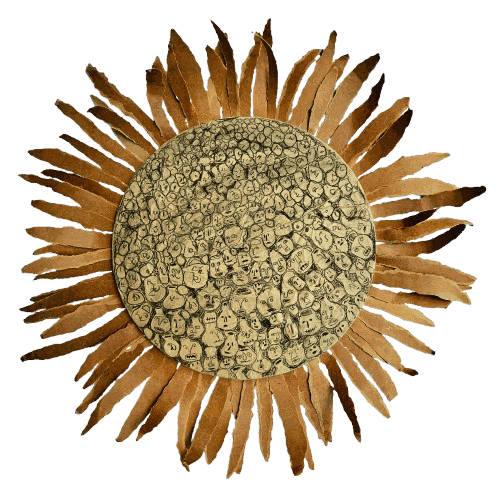In Bloom Song, Haughton, Holiday and Palmer show, that beyond violences of the past and present, it is art that insists on telling. And it is the telling that insists on beauty.
Bloom Song (épanouissement) is the change of season, the subtle shift from monochrome to colour, a shaping of poetry from history and a lucid becoming.
Three Black British artists working in different veins, take up poet Robin Coste Lewis’ provocation to ‘step forth into beauty without political shame.’
The loveliness of Des Haughton’s trees, branches snowed with bloom, disguise for a moment historical horror within. Speaking directly to these, Eugene Palmer’s portraits, executed in a graduated grisaille, subtly transform and remake the act of looking. While Amanda Holiday’s drawing of ghostly face jugs and towering sunflowers brings the conversation full circle.
For all three artists, blackness is a given, a perfusion of subject rather than subject itself. Thus, Haughton’s desire to ‘depict history through the eyes of trees’, is both carefree in its intentionality, yet imbued with a history that once saw trees shadowed by lynchings, where branch, beam and wood became material for containment, confinement and geographic dispersal. In fact, Haughton discovered a surprising connection between botanical artists and the slave trade routes – since British naturalists of the 1800s travelled on slave ships in order to collect specimens from West Africa and beyond. Haughton says, ‘botanical drawing is part of the DNA of slave history and some early collectors were slaves.’ Haughton intentionally eschews traditional interpretation of the subject in favour of layered, foliaged and heady beauty. Forms of familial and ancestral memory unite the trio of artists. Over the years, Palmer has documented in paint, his extended and blended family in an array of bold portraits that interrogate and challenge the viewer. The unwavering gaze of Palmer’s immaculately rendered, mixed-race daughter in this set of four paintings, might at first suggest ‘Instagram lookism’ and selfie re-mix culture. Yet it is the very act of looking (again) at Palmer’s work which uncovers ideas about categorisation, race and colourism. Minute colour gradations in the four otherwise identical portraits prompt the viewer to cycle and recycle their own notions of how blackness and beauty are portrayed. Here, Palmer’s work comes into conversation with that of other black artists notably Gavin Jantjes, an early peer, whose ‘South African Colouring Book’ touches on similar themes. By activating a deeper viewer involvement – to look and look again, Palmer’s work also speaks to that of US artist Amy Sherald who shifts the focus away from skin colour with her own use of grisaille.
Holiday’s large painted charcoal drawing ‘Face Jugs and Sunflowers’ emerged from her research into black poetics and in particular, Robin Coste Lewis’ poetic response to an 1882 photograph by J A Palmer titled ‘Wilde Woman of Aiken’. Holiday became fascinated by the many forms of face jugs, reported to have been created by slaves working around Edgefield in South Carolina and perhaps used as grave markers, since some have been found along the routes of the Underground Railroad. In this drawing, one of a series that depict face jugs, Holiday’s intention is to convey a sense of a living past and deathly aliveness replete with ancestral memory. In doing so, she speaks to print works by Anselm Kiefer and also Virginia Chihota. In other drawings, Holiday places a figure from the present in communion with the past. The face jugs are containers for a history, that insists on sprouting outwards and upward, taking the form of elongated sunflowers.
Like Palmer, Holiday’s portrayals include members of her own blended and extended family - often conveying a sense of one particular moment in time. Like Haughton too, Holiday’s depiction of uncanny beauty wrestles with the pervasiveness of history’s unsettled and unsettling legacy.
In Bloom Song, Haughton, Holiday and Palmer show, that beyond violences of the past and present, it is art that insists on telling. And it is the telling that insists on beauty.
Amanda B Holiday 2024
About the artists:
Amanda Holiday
London based artist and poet Amanda Holiday studied at Wimbledon School of Fine Art in the 1980’s. She was active in the British Black Art movement of the 1980s and exhibited her artwork in key shows of the time including Some of Us Are Brave, (Black Art Gallery), The Image Employed (Cornerhouse, Manchester) and Black Art, Plotting the Course, (Wolverhampton Art Gallery & tour) before moving into film. Her 1989 Arts Council funded documentary Employing The Image featured the early work of several UK black artists including Sonia Boyce and Zarina Bhimji, while her BFI funded experimental drama Miss Queencake re-imagines a slice of Gauguin’s life as a northern boat movie. In 2001 Holiday moved to South Africa where she worked in educational television. On her return to the UK with her daughter, Holiday resumed art making and later started writing poetry. Her chapbook The Art Poems was published in 2018 as part of New Generation African Poets and other writing has been published in journals internationally. In 2020 she founded Black Sunflowers Poetry Press with a focus on women and black poets and is currently completing a PhD (Poetry, Race and Art) at the University of Brighton. Her 1987 drawing ‘Red Riding Hood’ was shown as part of Women in Revolt! at Tate Britain (Nov 2023 - April 2024) and a recent drawing ‘It is’ was auctioned as part of this year’s Drawing Room Biennial. Holiday is the 2024 recipient of the Peut Guard Artist Award as well as a forthcoming travel fellowship to the Smithsonian (NMA AHC).
Des Haughton
Des Haughton lives and works in London. Born in 1968 to parents who arrived in England as part of the Windrush generation, his mother was from Guyana and his father from Jamaica. Since he was a young boy, Haughton became fascinated by drawing and painting. In 1993, Haughton graduated from the Slade School of Fine Art with a postgraduate Higher Diploma. Haughton has exhibited in museums: Hull City Museum (Autumn 2024), Southhampton City Museum and Art Gallery, Standard Charter Bank, Royal Academy, Birmingham Museum, Lord's cricket ground, Hartlepool Museum, BP Awards National Portrait Gallery, Inspired by the works of the Old Masters, Haughton was aware of a lack of representation of people of colour except to add exotic charm to a scene or in portraiture as a slave or servant. He observed that historically oil painting has been assumed to be the domain of those in power: the elite of Western society. Paintings were commissioned to act as the material embodiment of sovereignty, wealth, and imperial power - depicting life not as it was, but rather as their patron wished it to be seen. The genre Haughton has chosen to paint in becomes politically loaded when the painter and subject are both black. He is best known for his superb self-portraits and commissions of writer Angela Levy and cricketer Brian Lara. However, recently he has embarked on a new series of work depicting history through landscape and flora. He says, We cannot erase historical injustices, but we can reclaim territory denied us through challenging popular preconceptions as to what ‘black’ art can be. I aim to express the duality of my own experience; the sense of being both part of the English environment I was born into yet also displaced from it - connected to the Caribbean culture of my parents with its traditions, values, and historical inheritance.
Eugene Palmer
Eugene Palmer lives and works in St. Leonards-on-Sea, East Sussex. Closely associated with the BLK art group, whose members included Eddie Chambers, Lubaina Himid and Sonia Boyce, Palmer’s work is held in several public and private collections, including Arts Council Collection and Wolverhampton Art Gallery. Born in Kingston (Jamaica) and growing up in Birmingham (UK), Eugene Palmer moved to London to attend Wimbledon School of Art before completing the prestigious Goldsmiths MA course in Fine Art. At Goldsmiths, Palmer’s initial focus on abstract expressionism evolved into figuration; the University’s penchant for postmodernism, as well its theory-driven approach to making, infused the young artist’s painting practice. In the intervening decades, Palmer’s work has been enriched by myriad influences and experiments; always, it has insisted on its initial (intoxicating) combination of concept and craft. Palmer’s most frequently painted subjects are people. Sourcing images from life (family albums), pop culture (magazines, websites) and beyond, the artist begins with a photograph before passing it through his painterly filter. Occasionally, his work incorporates elements of collage — photos from various sources spliced into one tableau— or reproduction, wherein the artist will subject one image to multiple iterations. Sometimes, a colour will be switched between versions; in other cases, it’s the artistic process itself that, via replica and repetition, is subject to conceptual investigation. Circling themes of identity, Palmer’s painting invokes other lenses of mediation and meaning too — specifically, those applied by human beings to one another, delineating communities and prescribing an insidious hierarchy. Drawing on the experience of being immersed in British culture while remaining symbolically outside of it due to the colour of his skin, Palmer deals deftly with issues of race and representation all while resisting didacticism. Animated by the artist’s own subversive oeuvre, Palmer’s subjects (often painted at larger than life-size) are free to encounter their audience as well as be encountered by them.
Eugene Palmer is represented by Ed Cross Gallery.





